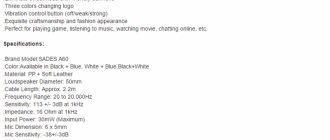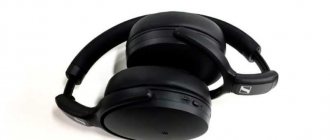Vladimir Papazov 04/14/2016 15942
Monitor sound is the main feature of the Sennheiser HD 650 headphones . This is why they are so appreciated by “audiophiles”, as well as those who work with sound. As a tool in this area, the HD 650 performs well.
When it comes to music, the Sennheiser HD 650 monitors are suitable for anything, as long as you are interested in the exact sound that is on the recording. You won't find any hypertrophied bass or ringing highs here. Great for classical, jazz, vocals, and generally “audiophile” music. Naturally, full-size open.
The price of the HD 650 is high, but $500 is worth paying only when you really need such wonderful sound, if you are an audiophile or a sound specialist. Otherwise, check out the inexpensive models.
Ergonomics
Like all other “open” and “semi-open” headphones, the Sennheiser HD 650 do not provide any isolation from external noise.
The Sennheiser HD 650 fits quite comfortably on the head - although it is possible that some users may find their fit a bit harsh. The pressing force of the cups on the Sennheiser HD 650, in our opinion, slightly exceeds the optimal level. Therefore, the headphones hold firmly in place and do not try to fly off - even with sudden movements of the head; but, at the same time, they can tire the ears with prolonged use.
AKG K 701
Design
The flagship of the Austrian company's model range, open-back 62-ohm headphones contain a patented Varimotion driver: a double-layer diaphragm transmits high frequencies with its thicker central part, and the rest of the range with its thinner and more flexible periphery. Apparently, the driver as a whole does not work like a piston, but according to the bending wave principle, similar, for example, to the Manger MSW wideband speaker. A voice coil with a flat wire is oriented in the field of a neodymium magnet. According to AKG, the drivers have independent ground traces (true bi-wiring), which, however, come to a single standard 1⁄4/1/8-inch jack (adapter included). The signal cable (cannot be uninstalled by the user) uses copper wires (99.99). The headphones are quite comfortable thanks to large ear pads with soft fabric and a not very stiff spring that connects the ear cups; The only thing that causes slight discomfort is the stylish leather headband, which does not fit the head, contacting only the crown.
Sound
Crystal transparency, airiness, liberation (especially in the upper register), exquisite detailing, tonal evenness and very high timbral resolution were evident when transmitting various music, primarily works for a small or small number of performers. The AKG K 701 is one of those components whose sound you immediately like and does not disappoint later on. The musical environment contains a wide plastic score of secretly intimate halftones, reflections and angles, a subtle play of chiaroscuro. There are no restrictions at the edges of the frequency range. The bass is precise, perfectly structured, quite deep (impressive organ pedal, orchestral bass), and does not differ in character from the middle. AKG organizes direct communication with the listener’s sensory sphere, as if bypassing the mental stage of perception; at the same time, the sound is very strict, without distortion or liberties.
In the dynamic area, the K 701 has no limitations, but the most impressive advantages of the model are concentrated near the line that separates sound from silence: the headphones operate here with unusual subtlety and refinement, carefully extracting musical colors, textures and contours from the inaudible region. The K 701 reproduces the sound of a piano (two-microphone recordings of S. Rachmaninov’s playing) flawlessly; the depth of timbre and the free soaring of overtonal trains can be clearly heard.
Sound
About the same as there are not big differences in appearance, they are not big in sound either. Moreover, I would not even clearly differentiate them in terms of older/younger models, because in terms of quality they are approximately at the same level. Well, okay, of course there are improvements as the index increases, but very small. They are more noticeable in terms of differences in taste. But first things first.
Sennheiser HD 600
The headphones are designed for monitoring and it shows. Smooth presentation without particularly emphasizing certain aspects of the composition. In addition, good speed, elaboration of small details and nuances of the composition, as well as the spatial structure of the scene also play a role. If the task of monitors is to be dry and impartial, transmitting the recording as it is, not forgiving anyone or anything, not trying to motivate the musicians, adding a plus to each person’s charisma, then the 600s are monitor headphones.
Of course, the model does a good job of showing the nuances of the recording and source. I don’t want to say, however, that the Sennheiser HD600 are headphones that decompose the recording into atoms or pull out joints, reproaching the listener with them. No, they just play it the way it is. So if the recording is worthy, get it and sign it. Beautiful overtones, soulful vocals or instruments, good control and range development. Well, if you are an HF-phobe and/or the recording is not so hot, then please hear this too. So the model will definitely cut for someone. But this can hardly be attributed to its disadvantages. It’s just that some people hate any headphones that have high frequencies. And here they are not only there, but also not softened in the traditional manner. As a result, smoothly, technically, monitorly, openly, naturally, impartially.
LFs have good control and depth. They do not stand out against the general background, but if the recording requires it, they can create the necessary weight, pressure and foundation of the composition. However, I repeat, if you need it to pump and hammer, don’t do it at all. It will be exactly as it is in the recording. Hence the advantages in the form of excellent control, delineation, detail and detailed elaboration of the range. In addition, the headphones convey the character and dimension of instruments well, revealing well the peculiarities of sound production.
The midrange is also devoid of accents. Each performer has exactly his own level of charisma. In this case, there are no problems with transmitting the proper pressure and weight, but, again, if this is already in the composition. If not, then either the vocalist can’t sing (welcome to reality - this happens often) or the energetic concentrated sound that metalheads love so much doesn’t come out, then I’m sorry. All by ourselves, all by ourselves. Learn. Headphones don't do any favors. At the same time, the nuances of the recording are perfectly conveyed.
In general, the Sennheiser HD 600 pays more attention to micro-details. So for some they will definitely be a tool for preparing a composition. And, naturally, the HD 600 allows you to track individual parts of instruments, focusing your attention on them. And yet, I can’t say that the macro component of the composition suffers greatly from this. No, she's just not in first place. Well, as for natural wooden instruments, they sound great. Same with electric guitars. They not only growl, but also differ depending on the compositions, without turning into one abstract electric guitar for all the music in the world. And there are no problems with transmitting the timbre and pressure of such vocalists as, say, Mike Patton. Exactly the same as with the transfer of various effects on vocals or the nuances of mastery of them.
HF - as I already said, it will definitely nag someone. So if you are inclined to be afraid of sibilance or simply low-quality recordings, you definitely shouldn’t buy headphones without listening. For the rest, serving 600 will result in excellent development of attacks, decays, and detail. Thanks to good control and speed of range, the headphones are able to cope well with both the high decay of live instruments and electric ones. The percussion sounds good, conveying the whole scattering of cymbals, bells and triangles. At the same time, electronic spatial effects also sound great.
stage is wider than average. At the same time, the headphones do not tend to inflate it; if we are talking about a chamber recording with a couple of instruments, then it sounds like that. If this is an assertive, driving rock musician, then he also maintains the proper dimension and emphasis on emotions. Well, if this stadium rock is recorded accordingly, then there will be width, scale, and scope. But without pumping up the weight and forcing the choice of a frontman.
Sennheiser HD 650
First of all, it's a slightly different presentation. The headphones maintain approximately the same tone, adding neither warmth nor coldness, but they literally make the sound a little fatter (mainly in the low frequencies) and shift the presentation to a slightly more coherent one. At the same time, the sharpness and definition are slightly reduced, giving a little more weight. Well, they soften the tops a little, and also remove the length a little. As a result, in direct comparison, the 650s are a little more cohesive, more massive and darker. In addition, approximately the same sensitivity is maintained.
LF is one of the main differences. It seems that the Sennheiser HD600 range was taken and shifted down a little. As a result, the bass here is a little deeper and more massive. Without going into the warmth, it literally gains a little fat. The latter, however, is worth talking about only in comparison, because in fact, the presentation here rather goes from being slightly dry in the 600 to conditionally neutral. Ultimately, this benefits the persuasive sound of the instruments, giving them a little more weight and relief. And as a result, involvement. In addition, the last point becomes more pronounced due to a more holistic presentation.
Midranges have retained their attention to the nuances of recording and elaboration of micro-details, but there is already a plus for charisma. However, this is probably too much. The curtsey is very neat. Care is maintained in conveying the character of the instruments, as well as their dimensions and sound production. In general, those who cannot sing will still not have a head start.
HF – first of all, not so long. As a result, the criticality of the recording is slightly lower. But this way the 650s are darker. Secondly, there is a slight mitigation here. It cannot be said that in this context the model is noticeably more comfortable, but a little - yes.
The stage lost a little in width, but gained a little in terms of depth. There is a more full and rich transmission of the sound canvas. If the 600s work well on the structure and separation of plans, then a little more attention is paid to their interaction. There is literally a little less air between the instruments and they are a little larger in size.
Sennheiser HD 660s
To put it very briefly, the model embodied the best that was in the presentation of both previous models and even improved it. Refinement and elegance in the transmission of high frequencies, giving the composition good naturalness and naturalness, were combined with weightier and (again) more natural low frequencies. In addition, the signature presentation of the midrange has been preserved - good elaboration of details and nuances of the composition. Attention to the features of the recording, conveying the character of the instruments and the sound features of a particular part.
In terms of bass , the Sennheiser HD 660 s are approximately on par with the 650 model. Except that along with good extension, a more noticeable lowest component, the bass has become a little more collected. It's a little less fat, but still more massive than the 600's. As a result, the blows have good definition, weight, and avoid overly sharp delivery. On the other hand, there are still no problems with the speed and transmission of technical aspects of recording. The bass here is simply more balanced than in both models. And as a result, it is more natural.
Midrangers have the same attention to detail. They are rather micro-detailed, thanks to which they manage to convey the character of the instruments well. If we talk about the balance of micro and macro, then the Sennheiser HD 660 s is more of a golden mean. So they perfectly manage to convey small nuances, filling them with timbres and weight to the proper extent.
HF , again, is the golden mean. No, they are closer to the 600s, but, nevertheless, here they are prepared more carefully, due to which it is possible to better convey the character of the instruments, attenuation, overtones, and this is all for which good highs are so loved. As a result, it turns out less harsh than the Sennheiser HD 600 and not as soft as the 650s. That is the golden mean. And along with a slightly deeper dynamic range, the result is a more honest, correct and natural presentation.
scene is exactly the same - it has the best of both worlds. The only difference is that it is not just the best, but also a little bit better. Due to this, the presentation is more correct, the structure of the scene is more realistic, and the positioning of the instruments is also better.











